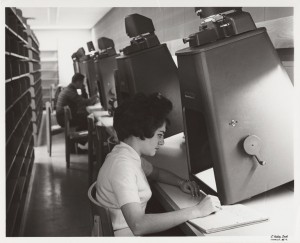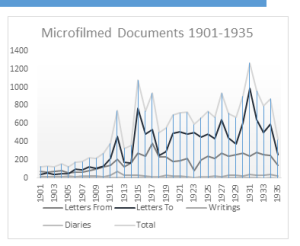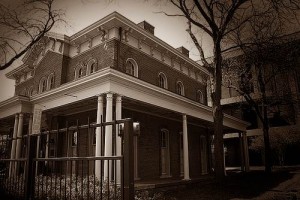
As Halloween nears, we turn to the more spirited side of the Hull House that Jane Addams started. The House itself, which was built by Charles Hull in 1856, was in an area of Chicago that was extremely fashionable before the Great Fire in 1871. After the Great Fire, the wealthy of the area left and moved to other areas, leaving the West Side of Chicago to be turned into a place for the poorest of the poor, from prostitutes to immigrants. It was these people that Jane Addams and Ellen Gates Starr wanted to reach out to. They therefore rented the house…and made a surprising discovery. The house was haunted by Charles Hull’s late wife.
Addams and Starr were not the first inhabitants of the Hull House to meet the late Mrs. Hull. The house had been rented out before and the tenants saw her ghostly figure in the room that had been hers. Terrified, they attempted to combat it by placing a pitcher of water over the threshold, believing that spirits could not get over the running water.

Addams slept originally in the room where Mrs. Hull died, which was where her spirit allegedly remained. While there, she saw Mrs. Hull a few times and, though Addams determined that she seemed to mean no harm, eventually decided to move into another room. They did not completely close off the room, however, and sometimes had guests stay in there. Some of these guests also saw Mrs. Hull’s spirit. Today, the house is included on Ghost Tours in Chicago and has a reputation as one of the most haunted places in Chicago, despite the relatively benign nature of the ghost.
In addition to the rather less frightening ghost of Mrs. Hull, there was the rumor of a Devil Baby ensconced in the attic of the Hull House. Though Jane Addams continually denied the existence of such a disfigured child hidden away in the attic, the legend persisted and even grew before it eventually died down, though it never vanished completely. Jane Addams herself took to The Atlantic in 1916 to explain the truth of the matter. In that article, she explores not just the legend of the Devil Baby, but why that story held the minds of the women that she serviced.
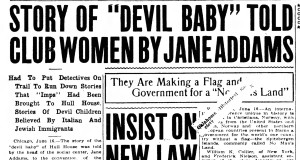
The Devil Baby has two different versions, one for the Italian Catholics and one for the Jews, though they were essentially the same. In both versions, there is an innocent bride whose husband is the villain and causes their child to be born with horns and a tail- a Devil Baby. In some versions, the baby can also spout profanity within a few months. All stories, however, conclude with the distraught mother bringing the baby to the Hull House, where a mystified Jane Addams locked it in the attic because she had no idea what to do with it.
This story, of course, was fervently denied by Addams and the rest of the Hull House staff. They insisted that the first time they ever heard the story was when two women appeared at the doorstep, wanting to see the Devil Baby for themselves. Though they were quickly turned away, they were just the first in a steady stream of visitors, seeking to see this mysterious child. Though the child never existed, the legends of it persisted, and in many ways are similar to other urban legends, such as the Jersey Devil.
So why do these kinds of stories hold the imaginations of the people, even today? Jane Addams’ theory was simply that they were a form of warning tale. Abuse was exceptionally prevalent in this period, particularly domestic abuse of wives by their husbands. Thus, the story of the Devil Baby is a morality tale of what can happen when the man of the household fails to be faithful and appropriately religious and therefore disrespects his wife and family. Though there was no actual Devil Baby caused by a cruel father, the hope that it gave the women that it would keep the menfolk in line to hear of the potential consequences of their actions was an important aspect of Jane Addams’ work and this rumor helped her determine where the women needed the most help.
Whether the hauntings of Hull House were real or not, they are certainly a rich part of the house’s legacy and the importance of the house in the history of Chicago.
Sources:
Jane Addams, “The Devil-Baby at Hull House,” The Atlantic, Oct. 1916.
“Social Settlement as Contested Space: Addams’ Personal Faith versus her Public Uses of Relgion,” in Urban Experience in Chicago: Hull-House and its Neighborhood, 1889-1963.
“Jane Addams and the Legends of Hull-House,” Chicago’s Haunt Detective.
Margaret Szydlik: The Publicity Assistant for the project, she is expected to graduate with a BA in History, with minors in French and Anthropology in May 2017. Her job is focused on the social media associated with the project, updating and maintaining the blog, and garnering public interest in the project, though she is also involved in the transcription of the documents. She can be contacted at mszydlik@ramapo.edu.



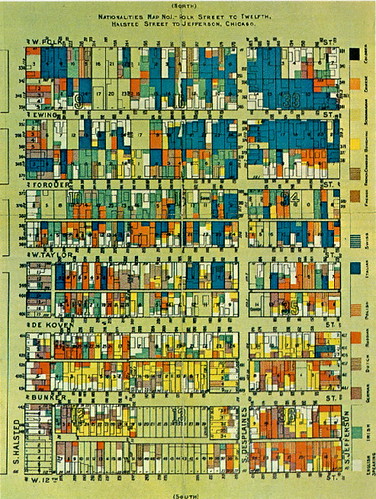

 When Progressives looked to immigrant neighborhoods, they saw society’s flaws acted out in juvenile delinquency–child labor, poor housing and education, poverty, and a lack of public entertainments. Fixing the problems did not start with the individual or with the immigrant community itself. Addams called for education as the only means of:
When Progressives looked to immigrant neighborhoods, they saw society’s flaws acted out in juvenile delinquency–child labor, poor housing and education, poverty, and a lack of public entertainments. Fixing the problems did not start with the individual or with the immigrant community itself. Addams called for education as the only means of: Between 1976 and 1983 the original staff of the Jane Addams Papers Project, led by Mary Lynn Bryan, undertook a massive search for Addams documents, searching thousands of archival collections and locating documents in 574 of them. These documents, microfilmed in 1996, will serve as the base of the new Jane Addams Digital Edition. We estimate that they found almost 20,000 letters from the period between 1901 and 1935. They also found evidence that not everything had been preserved. Some documents were lost, but others were deliberately destroyed.
Between 1976 and 1983 the original staff of the Jane Addams Papers Project, led by Mary Lynn Bryan, undertook a massive search for Addams documents, searching thousands of archival collections and locating documents in 574 of them. These documents, microfilmed in 1996, will serve as the base of the new Jane Addams Digital Edition. We estimate that they found almost 20,000 letters from the period between 1901 and 1935. They also found evidence that not everything had been preserved. Some documents were lost, but others were deliberately destroyed.

